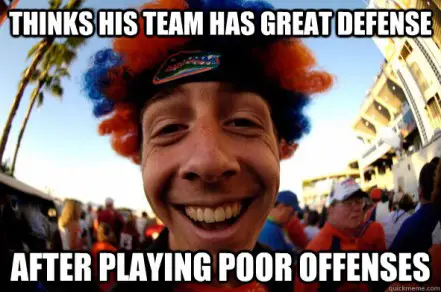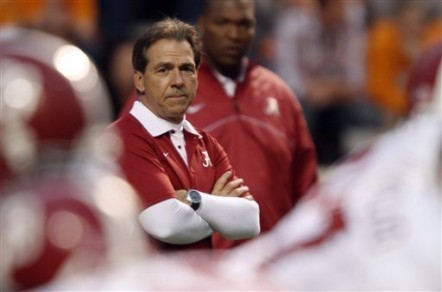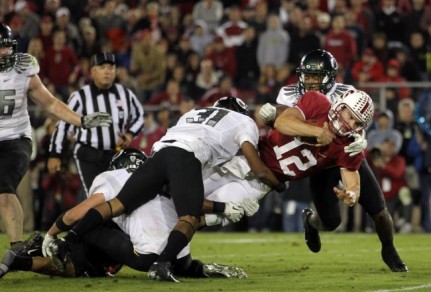 Over in EssEeeSee country, the “company line” is that the Pac-12, chock-full of spread-offenses and speed-based defenses, is full of sissies. Yeah, I said it, sissies. The Pac-12 “powers” can beat each other with “finesse” and “systems,” but when they come down to the South to play some “real football” (the term may be “footbaw,” as yet unconfirmed), the West-Coast-latte-drinking-spread-offense-running-hippie-non-croakie-wearing speedsters can’t hang.
Over in EssEeeSee country, the “company line” is that the Pac-12, chock-full of spread-offenses and speed-based defenses, is full of sissies. Yeah, I said it, sissies. The Pac-12 “powers” can beat each other with “finesse” and “systems,” but when they come down to the South to play some “real football” (the term may be “footbaw,” as yet unconfirmed), the West-Coast-latte-drinking-spread-offense-running-hippie-non-croakie-wearing speedsters can’t hang.
During this six-year stretch of sweaty, deep-fried, twangy SEC dominance of the BCS National Championship, rarely-outshouted SEC fans have proclaimed far and wide that “real” football is about going at people. It’s about pounding the ball north-and-south. It’s about stopping opponents from pounding the ball north-and-south. (Do SEC fans even like passing touchdowns? Unclear.) Ipso facto, during this six-year run, southern fans and some commentators (I won’t name… LOUDCOUGHCRAIGJAMESLOUDCOUGHMARKMAY) have conflated the up-the-gut, plug-and-chug style of play – and only that style – with “real football.”
This conflation is, in a word, erroneous.
And, in true FishDuck fashion, I’ll show you why.
Everyone knows that a football field is 100 yards long. Fewer people know the precise width of a field: 53-and-a-half yards. That’s 160-and-a-half feet wide! 100 yards x 53-and-a-half yards equals 5,350 square yards, or 48,150 square feet (or roughly the size of Phil Knight’s guest bathroom). So what do you get when you put 22 players in a 48,150 square-foot area? A lot of open space.
If the SEC Theory were correct, then the game of football would involve a lot less real estate. If north-south-north-south were the name of the game, then the field would only be as wide as the hashmarks. Let’s go back to our equation above: 48,150 square feet divided by 22 players = 2,188 square feet per player (or roughly the size of Phil Knight’s television). And that means a football field is – all together now – A LOT OF OPEN SPACE.
Ergo:
There wouldn’t BE that much open space on a football field if teams weren’t supposed to USE that much open space.
Say it again:
There wouldn’t BE that much open space on a football field if teams weren’t supposed to USE that much open space.
So, IF:
- The point of football is to gain yards towards the goal line.
- A football field is big.
- A yard gained on the sideline is equal in value to a yard gained in the center of the field.
THEN:
- Football teams can gain yards from anywhere they damn well please.
There is no reason why “football” must be equated to “being good at gaining yards over and through defenders.” Of course, I concede that doing so is valuable. But “football” can also be equated to “being good at gaining yards where defenders do not exist.”
 As we’ve heard Chip Kelly say, the no-huddle spread is a lifestyle. The scheme is crafted from critical thinking about how football conventions accepted as gospel can be challenged in a way that optimizes offensive snaps, within the rules. Innovative coaches realize that accepted conventions about speed, spacing, time of possession, play design — even player substitutions — were non-sacred cows just waiting to be slain. Football traditionalists are scared of the no-huddle, do not like the no-huddle, because it forces them to re-think what it means to “play football.” (See: Saban, Nick – 10/3/12 press conference.)
As we’ve heard Chip Kelly say, the no-huddle spread is a lifestyle. The scheme is crafted from critical thinking about how football conventions accepted as gospel can be challenged in a way that optimizes offensive snaps, within the rules. Innovative coaches realize that accepted conventions about speed, spacing, time of possession, play design — even player substitutions — were non-sacred cows just waiting to be slain. Football traditionalists are scared of the no-huddle, do not like the no-huddle, because it forces them to re-think what it means to “play football.” (See: Saban, Nick – 10/3/12 press conference.)
But guess what? Throughout history, traditionalists who have resisted important changes have lost.
Every. Single. Time.
And pretty soon those nay-saying SEC fans won’t have any more laurels to rest on: they’ll have been swept away by another speeding Duck on his way to the end zone.
Related Articles:
Chip Kelly Update: Everything's Good Again ...
Chip Kelly Update: Wailing and Gnashing of Teeth
Shock and Awe -- The Oregon Ducks' Football Hangover Effect
Despite Lopsided Score, Georgia State "Never Stopped Believing"
Hope Springs Eternal for Ducks
Incompetent Pac-12 Officials: How Do You Miss ALL of THIS?
With a high school defensive-coordinator-turned-offensive-coordinator-turned-head-coach as a father, Sean Goodbody has always had an interest in the X’s and O’s of football. He played two years with FCS University of Pennsylvania as a fullback, but having grown up in a football family Sean has spent much of his life studying the game–reviewing game film, designing offensive and defensive schemes, and game-planning upcoming opponents.
Sean has coached running backs, option quarterbacks, linebackers, defensive linemen, and safeties for his dad’s high school program. He has been a rabid Duck fan since meeting his significant other Maeve (an Oregon grad). Residing in Grand Junction, CO, Sean and Maeve both work as attorneys while cheering on their beloved Ducks from the Rockies.

